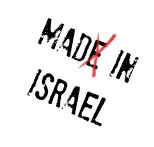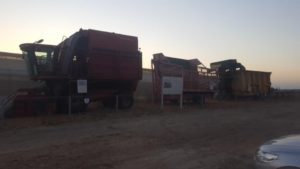Hi,
We had Jannaeus end or year party in Kibbutz Einat pool. We had some nice pool party, taking into the fact Jannaeus does not like water. He hates it when his face get wet, and prefer to stay out of the pool as much as possible.
Getting out of there Jannaeus noticed some trucks standing outside the pool. Unlike water he loves trucks, and noticed some explanation signs I love. So we had good reason and we went over to see what are those trucks.
It happened to be Kibbutz Einat Cotton heritage site. Those machines worked on the fields around Kibbutz Einat until 2018, when the Kibbutz closed the production of cotton because it became uneconomic. Cotton was the main product of Einat, and was grown since 1955 (3 years after the foundation of the Kibbutz).
In its pick there were 5,000 Dunam, around the Kibbutz and in Lod Valley around Ben-Gurion Airport. It is planted in start of March and harvesting in end of August. The shrub grows up to 1.2 m high, and contains around 20 boll, each weight around 3 grams.
The Cotton heritage site contains 3 machines: A cotton picker, a rotate machine (middle wagon) and a cotton stapler. Today there are combined machines that does all the harvest and stapling.
- The cotton picker is a 4 rows cotton picked. In the first days the cotton was hand harvested. The first cotton picker got to Israel in 1956, and was single row, and was pulled by a tractor.
- The rotate machine (middle wagon), is the wagon that waited for cotton picker in the edge of the field to collect the cotton from it. It then pushed the cotton up and rotate it into the cotton stapler. was pulled by a tractor
- The stapler was loaded in cotton from the rotate machine, squeezed it using an hydraulic arm and packed it. was pulled by a tractor. Before it was hydraulic, it used to be man operated – the workers on the field used to jump on the cotton to squeeze it.
I must that before I looked into this, I thought that Israel is not a country for cotton. It is a water consuming agriculture, and we don’t have too much water over here. Cotton does consume a lot of water (about 450mm) what makes got for tropic or subtropic climate. Buy it seems there are two kinds of cotton, and the quality and most expensive is grown in a thin belt in the world where there is enough water, but absolutely no water in the summer. What makes Israel an Ideal place for this type of cotton. But it seems that during the years it became less economic and and less is grown in Israel.
Take Care
Gad
 Kibbutz Einat Cotton heritage site – the 3 machines
Kibbutz Einat Cotton heritage site – the 3 machines
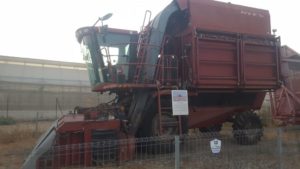 The cotton picker – The machine separate the cotton bolls from the shrub using two axis rotating in different direction. The cotton then thrown into the container using air pressure. This row cotton picker can harvest up to 4 rows of cotton shrubs.
The cotton picker – The machine separate the cotton bolls from the shrub using two axis rotating in different direction. The cotton then thrown into the container using air pressure. This row cotton picker can harvest up to 4 rows of cotton shrubs.
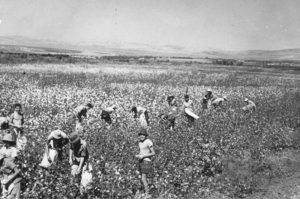 Cotton hand harvest in Israel in 1958 in Kibbutz Shamir (source: Pikiwiki)
Cotton hand harvest in Israel in 1958 in Kibbutz Shamir (source: Pikiwiki)
A new, combined cotton picker which harvest, pack and wrap the cotton in bales (each weight about 2.5-2.7
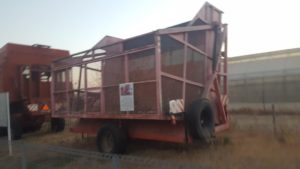 The rotate machine (middle wagon) – Used to pick the cotton from the picker, once its container is full. It then flipped it into the cotton stapler.
The rotate machine (middle wagon) – Used to pick the cotton from the picker, once its container is full. It then flipped it into the cotton stapler.
The rotate machine (middle wagon) in action
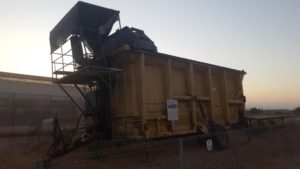 The Cotton stapler – This was an open wagon (no roof or floor), which was loaded with cotton from rotate machine (middle wagon). The wagon had an hydraulic system to squeeze cotton. Leaving behind a 9 ton module packed and ready to be carried.
The Cotton stapler – This was an open wagon (no roof or floor), which was loaded with cotton from rotate machine (middle wagon). The wagon had an hydraulic system to squeeze cotton. Leaving behind a 9 ton module packed and ready to be carried.
Video showing the cotton stapler in action.
